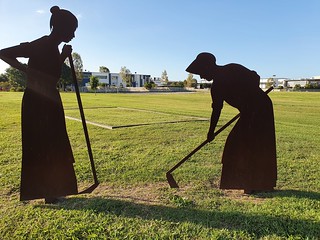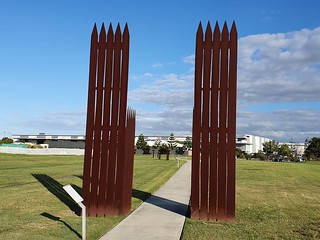In 1829, Captain Logan was looking for new agriculture land to expand the food production of the colony. Colonial Botanist Charles Frazer recommended a site that became known as Eagle Farm. Logan send 150 prisoners who cleared a site of 750 acres. Slab -barracks were built to house the convicts as well as a cottage for Superintended John Scottow Parker and a hut for the military guards.
In that same year, at considerable expense a wharf was also constructed at the farm, the only one in the colony apart from King’s Wharf in town.
As in town the main crop was corn but they also grew vegetables such as cabbages, potatoes, carrots and yams. The Farm made a great contribution to the food production of the colony.
The track between the main settlement and Eagle Farm was slowly turned into a road (Breakfast Creek Rd). In 1836, under Commander James Clunie a bridge was built over the creek and the road was later further extended to the farm – with also female prisoners working on the road. A proper bridge suitable for traffic was build in 1848, it collapsed the following year. Finally in 1858 a permanent bridge was erected. The road largely follows what is now Hamilton Road.
While they went of at a good start. A surplus of food – 300 bushels of maize, – was send to Sydney in 1830, they soon ran into problems. They suffered from both floods and draughts. What killed the early outer settlement was an outbreak of malaria in 1832. While there are reports that 680 of acres was under cultivation, this figure has later been questioned with estimates as low as between 46 and 280 acres. It looks like that from the earliest day also female convicts were employed at the farm.

The farm was however, not totally abandoned and was revived in 1836 under Commander Foster Fyan. He had a major problem with the Female Factory in the main settlement as he couldn’t keep the men under control who despite strict regulations broke the rules and entered the Female Factory. He thought by bringing them this far out that problem was solved.
The duties of the women remained the same as in Brisbane. See Female Factory. From now on the washing of the male convicts was weekly transported by a bullock wagon. They also did all the repair work of the clothes.
In 1836 Quaker Missionary James Backhouse visited the Farm. He mentioned that there were 40 female convicts some of them wearing chains. This was against British rules that forbid women to be chained.
By that time there were several timber slab buildings included the farm superintendent’s house, a two-room building for male prisoners who did heavy work, the Matron’s Quarters, female barracks (factory) with four rooms and sundry separate buildings including a one-room store, a one-room school and a one room hospital. The cook house had two rooms, one being a needle room where prisoners worked at sewing. The actual prison where women were locked up at night was a building containing six cells with a tall stockade or palisade type fence, the outer wall 5.2-metre (17 ft) high poles, the tops of which were sharpened. The superintendent’s and the matron’s houses were situated outside the stockade.

As the children could no longer go to the school in the main settlement a school was built in Eagle Farm, outside the stockade. The supervisor of schools was the Reverend Johann Handt who was also the chaplain he resided in Moreton Bay. The schoolmaster was the Factory Corporal McDonald. However, in 1837 he was removed because of misconduct.
Not that this fence prevented male intruders to find their way to the women. Women who worked in the fields could easily hide themselves in the tall grass and make arrangements for men to visit them there. and they were assisted in their escapades by the tall grass surrounding the area. For this reason it became increasingly more difficult to deploy the women outside the stockade.

However, sometimes it was even worse. The matrons were in charge off all of the female activities. The superintend was in charge of the overall management of the place. In all there have been 10 matrons. The first one Mrs McAuley was dismissed for smuggling and other irregularities. The 2nd one was transferred to Sydney after an all night orgy and the third one was exposed as a certain brothel madam.
In 1839 the remaining 57 convict women were shipped to Sydney and the penal settlement at Eagle Farm was effectively closed, becoming a government cattle station by 1841. The building was also briefly occupied by Assistant Surveyor Robert Dixon and by Commissioner for Crown Land Dr Stephen Simpson who also was an Acting Colonial Surgeon. Consequently it became farming lands and it also housed the very first airport. The site of the old buildings is currently a heritage area with an information centre.